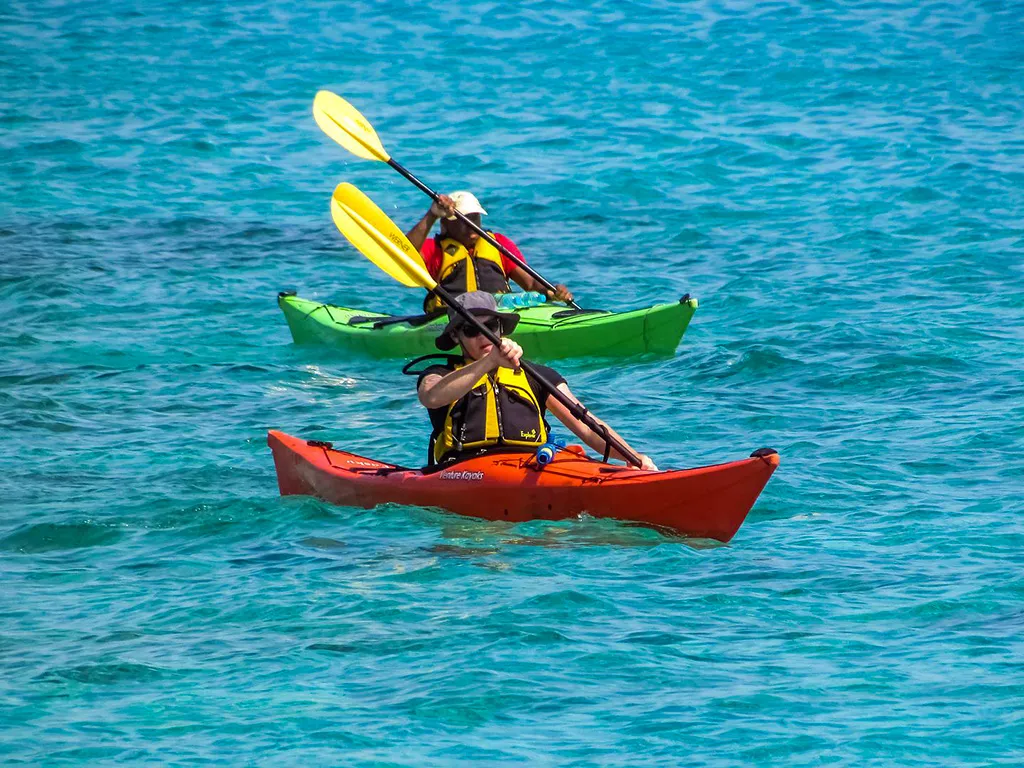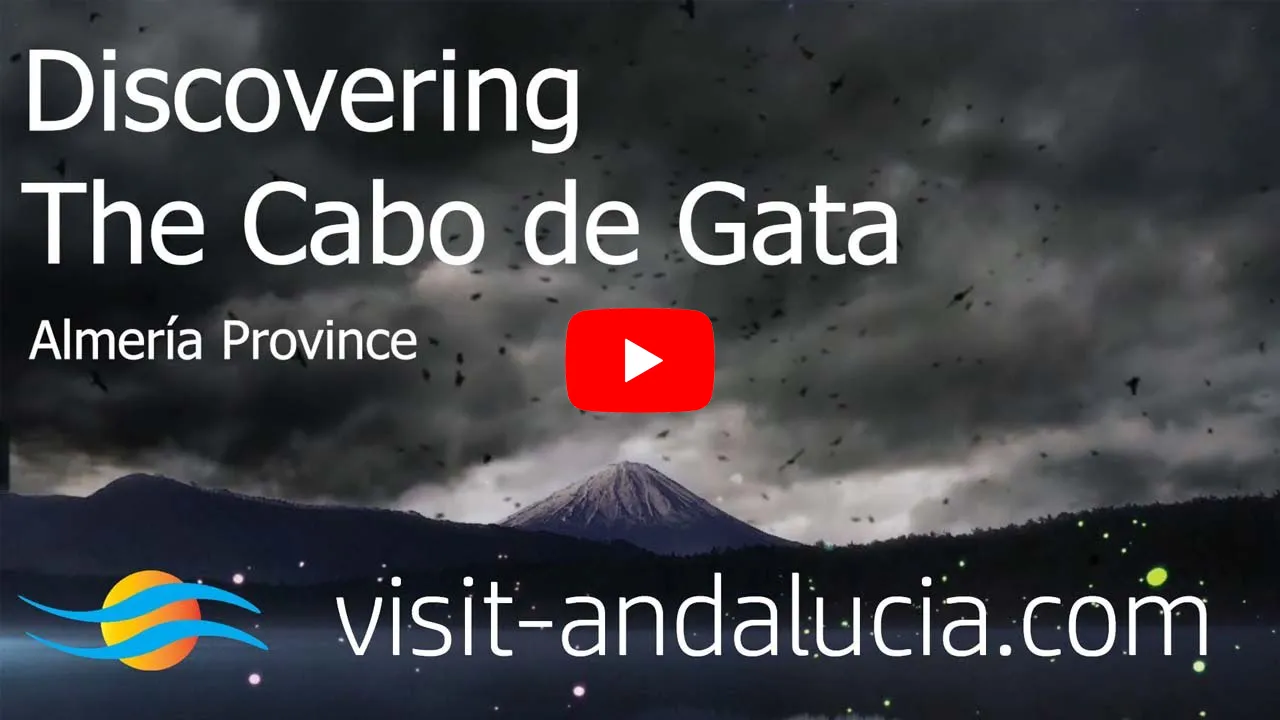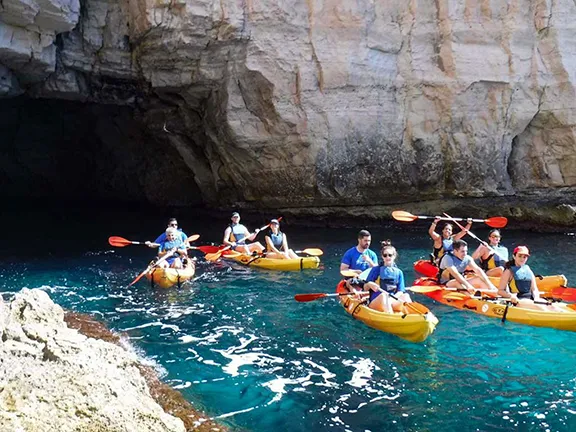Pirates, treasure, semi-precious stones, gold, fossils, cliffs, remote beaches and coves, caves and castles, reefs and underwater meadows teeming with sea life; a day spent canoeing along the coast of the Cabo de Gata provides a weeks’ worth of experiences that you will just not have by car or on foot.
By Nick Nutter | Updated 11 Apr 2023 | Almería | Places To Go |
Login to add to YOUR Favourites or Read Later


Spectacular beaches Cabo de Gata
If you asked me, ‘Why do you love the Cabo de Gata’?, I would probably ramble on about its beauty, its solitude, its wildness, or the harsh, volcanic landscape that is majestic and timeless. In truth I do not have an answer. All I know is that the area captivated me from the first moment I set foot in it some 20 odd years ago. Recently I discovered even more about this fascinating region, looking at it from another perspective, from the sea, by kayak.


Kayaking
It took many visits to the Cabo de Gata to even begin to claim that I know the place; its landscapes, wild life and flora, its history and culture. Even now some thing or some fact, will emerge about the Cabo de Gata causing me to think, ‘I did not know that’. I was sure there were still plenty of surprises left. I was to find that I had barely touched the surface.


Arrecife de las Sirenas
Did you know, for instance, that the name Cabo de Gata comes from the Spanish word for agate, ágata, a semi-precious stone found in the area? I had always assumed that the name of the area had something to do with cats, gato, and I even regularly misspelled the name due to this misapprehension. There are two notable places to find agate, the beach at La Isleta del Moro and the nearby beach at Los Esculos.


Cabo de Gata lighthouse
Further down the coast is the famous Cabo de Gata lighthouse. The lighthouse was built in 1863 in the central courtyard of an even older structure, the 18th century Castillo de San Francisco de Paula. The castle was built to defend the coast from pirates, the lighthouse is there to warn shipping of the notorious Arrecife de las Sirenas (Reef of Sirens or Mermaids).


Video By: Julie Evans


Canoe and snorkel Cabo de Gata
About 8 million years ago, the Cabo de Gata was emerging from the primordial Tethys Sea in a fury of fire and brimstone. Volcanoes shot lava into an atmosphere thick with pumice. The sea surrounding the volcanic vents boiled. Over many millennia the forces of nature became quiescent, and the volcanic landscape eroded. Incredibly, the Arrecife de las Sirenas are the last remains of the granite plug from a volcanic vent that once poured lava into the sea all those years ago. The ‘Reef of Sirens’ is so named because superstitious mariners believed that the monk seals that sunbathed on the rocks were mermaids and that their haunting cries were a siren call to lure ships onto the reef. Interestingly, during Roman times, the promontory was called "promontorius charidemi" which translates as "promontory of the agate". I did not know that until recently either.


Canoe and snorkel Cabo de Gata
The Cabo de Gata has a deep connection to the sea, the total area of the Cabo de Gata-Níjar Geopark is 474 square kilometres of which 120, fully one quarter, are in the marine protected area. This protection has preserved the coast of the Cabo de Gata in a pristine condition, the waters are crystal clear with thriving coal reefs, meadows of Poseidon grass and a fantastic and often colourful, eco system. The coastal beauty is best appreciated from the sea itself and a kayak is the perfect vessel for exploring the remote coves, sea caves and beaches that are not easily accessed from the land. Even in the height of summer, many of these isolated beaches are thinly populated by sun worshippers.
Three kayaking routes allow you to appreciate the wonders of the Cabo de Gata coastline.
This expedition takes approximately three hours. It begins at La Fabriquilla which is at the southern tip of the Salinas de Cabo de Gata, a haven for waders for the birdwatchers amongst us. From the beach, a gentle paddle takes you to Cala del Corralette. There you will have the opportunity to try snorkelling in the turquoise waters. Then you proceed to the Cabo de Gata headland itself. With the lighthouse high above, you can explore the Arrecife de las Sirenas before returning to La Fabriquilla.
This route starts at the 18th century Castillo de San Felipe at Los Escullos, on the coast, north of San Jose. It is an excellent way to explore the many small coves, including Cala Chica, Cala Grande and finally Cala Tomate. For hundreds of years prior to the beginning of the 19th century, these coves had been havens for the pirates that raided the Andalucia coast. The Castillo de San Felipe is just one of the many castles and watchtowers built along the coast to help defend the inhabitants of the coastal villages. You will have the opportunity to try your hand at snorkelling in Cala Tomate before returning to Los Escullos via a sea cave.
On the coast, in the centre of the Cabo de Gata, is a black, volcanic mountain, El Cerro Negro. At the foot of this mountain is the fishing village of Las Negras. The fishing boats still operate from the beach and you will still see a goatherd taking his animals through the streets from one pasture to the next in this timeless village.
From Las Negras, the kayak route takes you south past some of the most imposing cliffs in the park. You will enter a sea cave, the Cave of the Pirates and learn the legend attached to this cave before passing the Castillo de San Ramon. The castle was built in 1764 specifically to protect the gold miners who brought their valuable cargo from the nearby town and gold mine at Rodalquilar, to El Palyazo beach where it was loaded onto coastal vessels. The castle, an Asset of Cultural interest, is privately owned and has been maintained as a habitable mansion. In 2020 it was put on the market. The sales literature included amongst its many selling points, ‘a battery of four guns for possible but unlikely use against pirate attacks’.
The beach at El Playazo is remote and hosts fantastical sculptures, eroded from the fossiliferous, soft sandstone. The next destination is the even more remote, virgin cove of Cala Bergantin. Here you will find a teeming, underwater world. This cove is reckoned to contain the most varied number of fish and crustaceans in the Cabo de Gata, including some rather splendid starfish. A short stop here for snorkelling is an experience not to be missed and one taken by relatively few people.
You then return to Las Negras, the whole trip taking about three hours.
So, pirates, treasure, semi-precious stones, gold, fossils, cliffs, remote beaches and coves, caves and castles, reefs and underwater meadows teeming with sea life; a day spent canoeing along the coast of the Cabo de Gata provides a weeks’ worth of experiences that you will just not have by car or on foot.
On 17 November 2015, the UNESCO member states at the General Conference ratified the statutes of the new International Geosciences and Geoparks Program, legally approving the new UNESCO World Geopark label.
In addition to belonging to the European and Global Network of Geoparks since 2006, other protected areas fall under this category as a natural park declared in 1987; the Special Conservation Area (ZEC) and the Special Protection Area for Birds (ZEPA). In 1990, the Cabo de Gata Salinas were registered in the international list of Ramsar wetlands and in 1995 the Cabo de Gata-Níjar Marine Reserve was declared. UNESCO in 1997 declared this space as a Biosphere Reserve and the United Nations recognized Cabo de Gata-Níjar in 1999 as one of the Specially Protected Areas of Importance for the Mediterranean (SPAIM).
The Natural Park is accredited by the EUROPARC Federation with the European Charter for Sustainable Tourism (CETS) since September 2008.